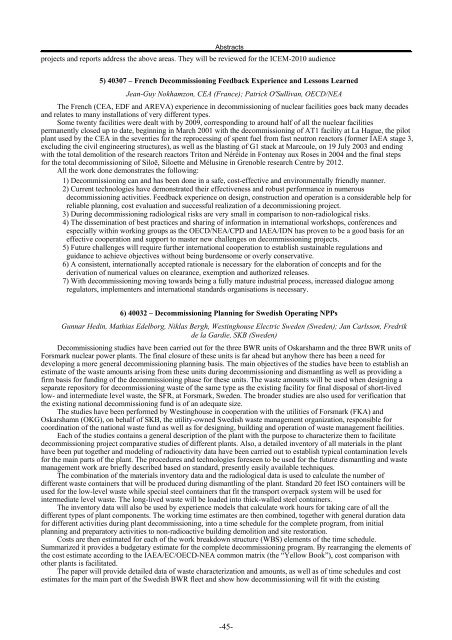ASME Message
ASME Message
ASME Message
You also want an ePaper? Increase the reach of your titles
YUMPU automatically turns print PDFs into web optimized ePapers that Google loves.
Abstracts<br />
projects and reports address the above areas. They will be reviewed for the ICEM-2010 audience<br />
5) 40307 – French Decommissioning Feedback Experience and Lessons Learned<br />
Jean-Guy Nokhamzon, CEA (France); Patrick O'Sullivan, OECD/NEA<br />
The French (CEA, EDF and AREVA) experience in decommissioning of nuclear facilities goes back many decades<br />
and relates to many installations of very different types.<br />
Some twenty facilities were dealt with by 2009, corresponding to around half of all the nuclear facilities<br />
permanently closed up to date, beginning in March 2001 with the decommissioning of AT1 facility at La Hague, the pilot<br />
plant used by the CEA in the seventies for the reprocessing of spent fuel from fast neutron reactors (former IAEA stage 3,<br />
excluding the civil engineering structures), as well as the blasting of G1 stack at Marcoule, on 19 July 2003 and ending<br />
with the total demolition of the research reactors Triton and Néréide in Fontenay aux Roses in 2004 and the final steps<br />
for the total decommissioning of Siloë, Siloette and Mélusine in Grenoble research Centre by 2012.<br />
All the work done demonstrates the following:<br />
1) Decommissioning can and has been done in a safe, cost-effective and environmentally friendly manner.<br />
2) Current technologies have demonstrated their effectiveness and robust performance in numerous<br />
decommissioning activities. Feedback experience on design, construction and operation is a considerable help for<br />
reliable planning, cost evaluation and successful realization of a decommissioning project.<br />
3) During decommissioning radiological risks are very small in comparison to non-radiological risks.<br />
4) The dissemination of best practices and sharing of information in international workshops, conferences and<br />
especially within working groups as the OECD/NEA/CPD and IAEA/IDN has proven to be a good basis for an<br />
effective cooperation and support to master new challenges on decommissioning projects.<br />
5) Future challenges will require further international cooperation to establish sustainable regulations and<br />
guidance to achieve objectives without being burdensome or overly conservative.<br />
6) A consistent, internationally accepted rationale is necessary for the elaboration of concepts and for the<br />
derivation of numerical values on clearance, exemption and authorized releases.<br />
7) With decommissioning moving towards being a fully mature industrial process, increased dialogue among<br />
regulators, implementers and international standards organisations is necessary.<br />
6) 40032 – Decommissioning Planning for Swedish Operating NPPs<br />
Gunnar Hedin, Mathias Edelborg, Niklas Bergh, Westinghouse Electric Sweden (Sweden); Jan Carlsson, Fredrik<br />
de la Gardie, SKB (Sweden)<br />
Decommissioning studies have been carried out for the three BWR units of Oskarshamn and the three BWR units of<br />
Forsmark nuclear power plants. The final closure of these units is far ahead but anyhow there has been a need for<br />
developing a more general decommissioning planning basis. The main objectives of the studies have been to establish an<br />
estimate of the waste amounts arising from these units during decommissioning and dismantling as well as providing a<br />
firm basis for funding of the decommissioning phase for these units. The waste amounts will be used when designing a<br />
separate repository for decommissioning waste of the same type as the existing facility for final disposal of short-lived<br />
low- and intermediate level waste, the SFR, at Forsmark, Sweden. The broader studies are also used for verification that<br />
the existing national decommissioning fund is of an adequate size.<br />
The studies have been performed by Westinghouse in cooperation with the utilities of Forsmark (FKA) and<br />
Oskarshamn (OKG), on behalf of SKB, the utility-owned Swedish waste management organization, responsible for<br />
coordination of the national waste fund as well as for designing, building and operation of waste management facilities.<br />
Each of the studies contains a general description of the plant with the purpose to characterize them to facilitate<br />
decommissioning project comparative studies of different plants. Also, a detailed inventory of all materials in the plant<br />
have been put together and modeling of radioactivity data have been carried out to establish typical contamination levels<br />
for the main parts of the plant. The procedures and technologies foreseen to be used for the future dismantling and waste<br />
management work are briefly described based on standard, presently easily available techniques.<br />
The combination of the materials inventory data and the radiological data is used to calculate the number of<br />
different waste containers that will be produced during dismantling of the plant. Standard 20 feet ISO containers will be<br />
used for the low-level waste while special steel containers that fit the transport overpack system will be used for<br />
intermediate level waste. The long-lived waste will be loaded into thick-walled steel containers.<br />
The inventory data will also be used by experience models that calculate work hours for taking care of all the<br />
different types of plant components. The working time estimates are then combined, together with general duration data<br />
for different activities during plant decommissioning, into a time schedule for the complete program, from initial<br />
planning and preparatory activities to non-radioactive building demolition and site restoration.<br />
Costs are then estimated for each of the work breakdown structure (WBS) elements of the time schedule.<br />
Summarized it provides a budgetary estimate for the complete decommissioning program. By rearranging the elements of<br />
the cost estimate according to the IAEA/EC/OECD-NEA common matrix (the “Yellow Book”), cost comparison with<br />
other plants is facilitated.<br />
The paper will provide detailed data of waste characterization and amounts, as well as of time schedules and cost<br />
estimates for the main part of the Swedish BWR fleet and show how decommissioning will fit with the existing<br />
-45-


